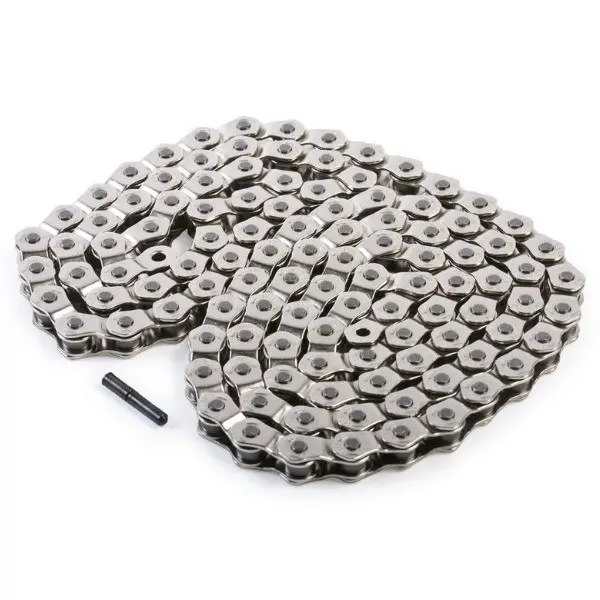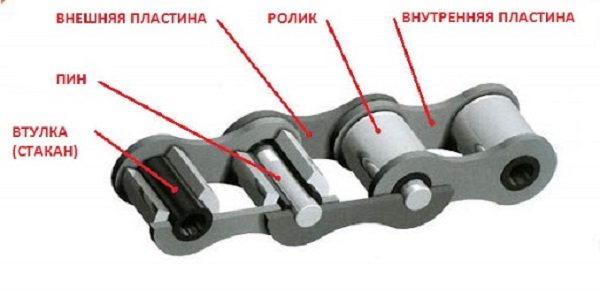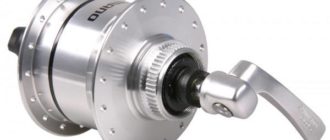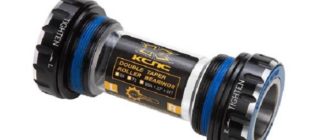The search for an optimal driveline began with belt and pinion drives. The first experiments did not satisfy the inventors, who found a more reliable and lighter weight option. Bicycle chain appeared on mountain bikes, road bikes, and touring bikes. The main element of the transmission, which interacts with the cassette stars, affects the wear and tear of the system in different ways. Therefore, you need to know the type and characteristics of the chain, which is selected for the conditions of use and must match the type of bike. We suggest looking together at the important parameters to consider when choosing a new part.
Design
Apart from Half-Link, the classic types of chains have the same construction:
- metal collapsible links are arranged in one plane;
- the inner and outer half-links are assembled alternately;
- the bicycle chain pitch (one half-link) connects the pin to the roller;
- full link is the same size (25.4 mm);
- The half-link is 12.7 mm.
One pair of links forms fragments from which any length of chain can be assembled. Half-Link has peculiarities. Here, each link enters the other on the roller in the same way and is not replaced in pairs, but individually. On speed bikes, the part is used without connecting sleeves.
Types of bike chains
All bicycle chains are divided into 2 main types, each with its own features.
- Roller (wear-resistant, rare type). The feature – the rollers are inside the links.
- Sleeve (common type not for professional use). Feature – to connect the links use the usual bushings.
Of the many modifications, there are 4 subspecies.
- Used in single-speed bicycles.
The simplest type is installed on children’s, urban, teenage models with a single-speed hub on the rear wheel. Thickened and durable plates made of stainless steel do not bend or wear out. Longevity is ensured by a straight chain, which bypasses the stresses of lateral curvature.
Multi-speed bikes.
The main features of bike chains:
- A recess in the chain accepts bending;
- thin plates and narrow sprockets;
- uneven load.
The chain jumps over the sprockets during gear shifting, causing the chain to skew. This causes the sprockets to wear out and the transmission element to wear out.
Lightweight chains
Empty hubs with holes in the plates can be installed on any bicycle. Most often the chains, which are 25% lighter than their counterparts, are installed on racing bikes. These chains tend to stretch and fail quickly because of handling.
- Halflink
The name of this element of the transmission means: half – half, link – link. The device is characterized by the following features:
- the part consists of identical (repeating) links;
- Among the advantages are easy length adjustment, the ability to use on a single and multi-speed bike;
- disadvantage – imperfect design.
Any bicycle chain deforms over time. This leads to rapid wear and tear of the system, which can be identified by a master with extensive experience. Therefore, professionals recommend applying the established rule: 1 cassette is 3 chains.
The most common sizes
When choosing a bike, consider 3 main values, the values of which indicate the differences between bike chains.
- The distance between the pins (pitch).
There is no need to measure the index yourself, because according to GOST on all modern two-wheeled vehicles standard pitch is 12.7 mm (1/2″).
- Chain width.
The standard is determined by measuring between the inner planes of the plates. The most common width dimensions (mm) are:
- 1-speed – 8.7-11;
- 7 speed cassette – 7,3;
- 11 stars in the cassette – 5.5.
The higher the number of gears, the smaller the distance between the sprockets and the width of the bicycle chain.
- Length.
Chains of 110-118 links are most commonly made to complete a bicycle’s drivetrain. For a 12-speed cassette, the figure increases to 126 links. The size is related to the type of bicycle. For example, ordinary mountain models require 106-108 links; new niner models require 112 links. You can determine the working length on your own.
For the Double or Triple system:
- open the lock (squeeze one link with your hands toward the other, wiggling from side to side);
- without extending the chain through the derailleurs, put on the front and back on the largest sprocket;
- connect in a closed circle, adding 1-1.5 links.
This measurement is relevant if the bike has 2 or 3 sprockets installed.
If you have a Single system (one chainring in the front and 9 to 11 in the rear), increase the chain length by 2 links.
Materials, Technology, and Performance
Properly made bicycle chains are lightweight, reliable, corrosion-resistant, durable drivetrain components. The quality of the part depends on the material, thermal and chemical treatment and coating technology. Bicycle chains are made only of hardened and stainless steel and titanium. Colored metal is not used because of its softness and fragility. Anticorrosive coating contains steel additives (e.g., cobalt) that have increased strength.
Specifications include lateral bending, which is measured with a load of 3 newtons (a measure of force in the International System of Units). Wear due to the elongation of the chain during use is related to the formation of a gap in each joint (there are more than a hundred of them). For example, if the narrow gap increases by 0.01 mm, the chain will lengthen by 1 mm. For bmx or bike chains that are ridden without shifting, the size of the gap affects the life of the model. If the recommended value is exceeded, grease and dirt can easily get inside and put the entire unit out of service.
Connection types
To facilitate the installation and disassembly of the chain, connection locks are used. The part is composed of two folding plates. In one of the sides is pressed a metal rod (pin). Manufacturers produce models with different types of connection. For example, SRAM Power Link and KMS produce bikes with a connector lock. Shimano and Campagnolo make bike chains without a connecting link. Locks for single-speed and multi-speed chains are differentiated by the way they lock. For example, in a multi-speed, the rivets are “built into” the design and do not protrude over the side plates. Modern inventors are trying to install motorcycle-like seals on the joints.
Marking
Manufacturers always indicate the geometric parameters of the chain, which they put on the package in 2-3 lines. The inscriptions help to know the correspondence of the bicycle chain to the number of gears. For example, cn indicates that the chain is designed for nine stars, and cn for 6-8. A smaller number of speeds is not indicated. Some manufacturers have other cn designations for gears: 5-7, 7-8, 11, 12 (Shimano chains). Bicycle chain marking is indicated in numbers and Latin letters.
Designation of numbers in the marking
To correctly decipher the inscription, let’s analyze a specific example. The marking on the box reads:
1/2″ X 11/128″ – 114 Links
pin length 5.88 mm
| Numbers in order | Meaning |
|---|---|
| First | Indicates the pitch of a bicycle chain. It is the same for all models (1/2″). |
| Second | Inner link width related to sprocket thickness |
| Third | Number of links, 114 |
| Number in second row | Pin length (outer chain width) – 5.88 mm |
Examples of common interior widths (mm):
- 2.18 – availability of 9-10, 20, 27 speeds;
- 2.38 – used in 6-8 speed cassettes;
- 3.18 – designed for single-speed bicycles and models with planetary hub.
The length of the pin is chosen after measuring the distance between the cassette gears.
There is another indicator – the strength limit, which is indicated by a number and letters kgf. The inscription indicates: to break the chain it is necessary to use a force equal to kilograms (for example, 700 kg).
How to choose a bicycle chain – recommendations
The main element of the transmission affects the condition and movement of the bike. An automated machine marks small links made of durable materials, and then secures them by riveting. When buying the necessary part, consider the advice of professionals:
- Choose a chain based on speed compatibility and specifications.
- Study the markings on the package. Numbers and letters indicate the actual performance, quality, suitable bike model.
- It is not recommended to buy chains made of aluminum and soft metal alloys. Such products have a short lifespan and service life.
- The strength of the chain can be determined by the color of the metal:
- gray, lacking luster – high quality;
- glossy white – medium quality;
- yellow-golden shade – low level.
- On children’s models, the length of one link should be less than that of an adult bike. For example, 11.4 mm instead of 12.7 mm.
- A deliberate choice of bike chain, proper adjustment, cleaning, and storage help avoid problems.
Conclusion
Elementary, but indispensable device does not require large financial investments. The part is present on every bicycle. The market provides a huge number of varieties and brands. The best manufacturers are recognized companies: Shimano (Japan), Compagnolo (Italy), KMC (Taiwan), Wipperman (Germany), Tyazhmash (Russia). How long the chain lasts depends on the right choice of biker.










